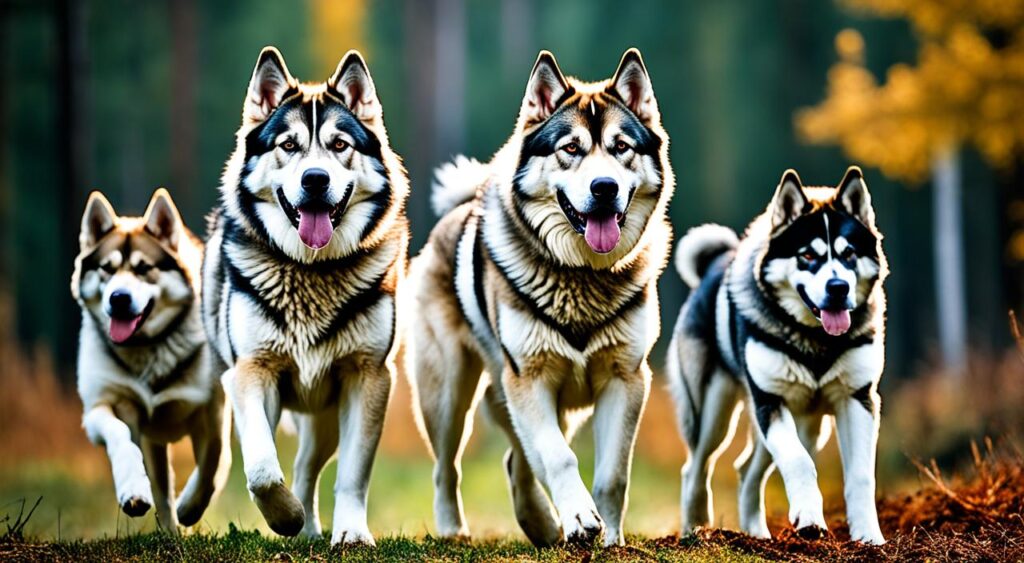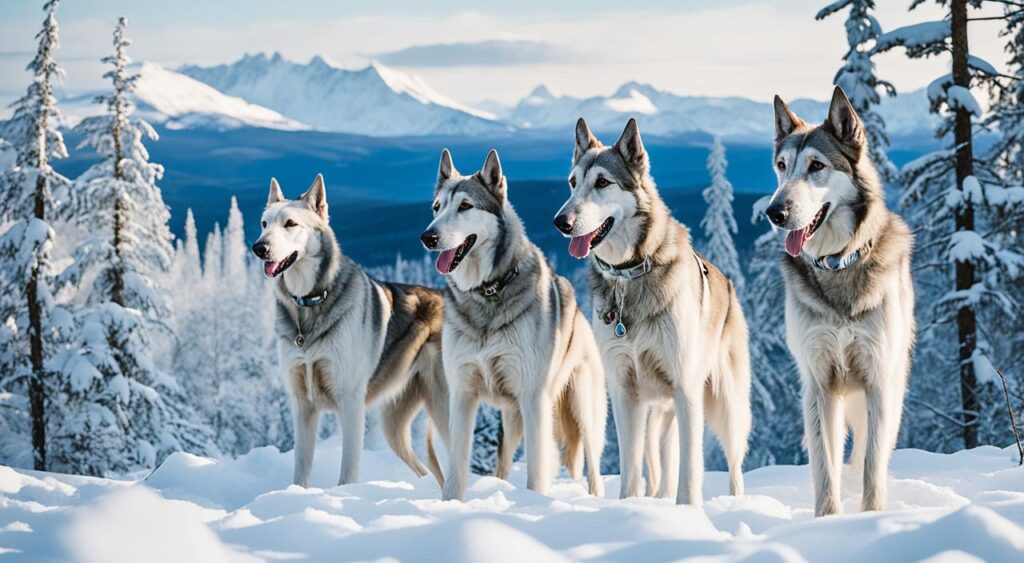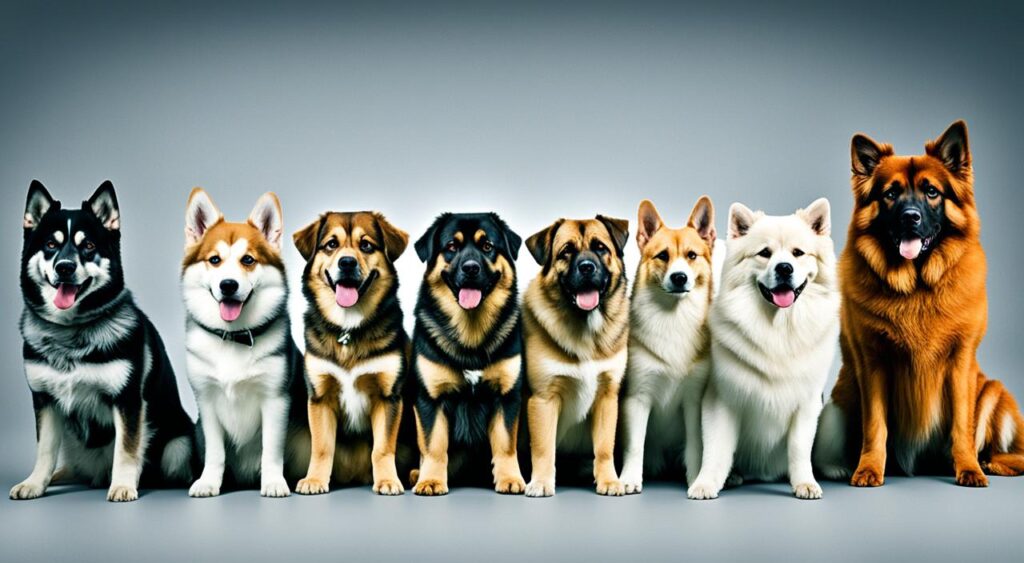Aggressive Russian dog breeds have a long history of being strong, loyal, and protective. These traits make them great at guarding and herding in Russia. But, their tough look can make people see them as dangerous. It’s important to know about their nature and history if you’re thinking of getting one as a pet or working partner.
Exploring Russian guard dogs shows their important roles. It also highlights the big responsibilities of owning such powerful pets.
Key Takeaways
- Russian dog breeds have strong protective instincts.
- Many aggressive Russian dog breeds serve as guard dogs.
- Understanding breed characteristics is crucial for potential owners.
- Historical roles significantly shape their behavior.
- Not all Russian breeds pose a danger; education is key.
Introduction to Dangerous Russian Dog Breeds
Dangerous Russian dog breeds are a big part of Russian culture and history. They were made for many jobs, like guarding and being friends. Their strength, smarts, and protective nature make them tough to handle in some places.
These dogs came from a mix of need and cultural importance. They are known for their strength and loyalty. This makes them perfect for protecting things. They are loved and respected in many places.
With the right training and socializing, these dogs can be great pets. They can be both loyal friends and watchful protectors.
People thinking about getting a dangerous Russian dog breed should know what these dogs are like. Finding the right dog for an experienced owner can make things safer for everyone.
| Breed | Purpose | Temperament |
|---|---|---|
| Caucasian Shepherd | Guarding livestock | Protective, loyal |
| Russian Black Terrier | Guarding | Confident, spirited |
| Russian Mastiff | Fighting, guarding | Aggressive, strong-willed |
| Samoyed | Herding, companionship | Friendly, vigilant |
Characteristics of Aggressive Russian Dog Breeds
It’s key to know about aggressive Russian dog breeds before getting one. These dogs have unique traits and looks that affect their behavior and fit as pets.
Temperament Traits
Aggressive Russian dog breeds show certain traits. They are often:
- Territorial: They guard their home and family strongly.
- Loyal: They form a deep bond with their owners, making great companions.
- Socially selective: They can be friendly with family and friends but wary of strangers.
- Assertive: Their confidence needs skilled handling for proper training.
Physical Attributes
Dangerous Russian dog breeds stand out with their looks. Key features include:
- Size: Many, like the Caucasian Ovcharka, are big and impressive.
- Muscular build: Their strength and stamina are vital for their work.
- Distinctive coat: Thick fur protects them in cold weather, and their colors make them stand out.
Knowing about these traits and looks is key for those thinking of getting an aggressive Russian dog breed. It helps in building a strong bond with the dog.
| Breed | Temperament Traits | Physical Attributes |
|---|---|---|
| Caucasian Ovcharka | Protective, Loyal | Large, Thick Fur |
| Rottweiler | Confident, Territorial | Muscular, Medium-Length Coat |
| Russian Black Terrier | Intelligent, Assertive | Large, Dense Coat |
Popular Russian Guard Dogs
Russian guard dogs have been key in keeping homes safe. They show great loyalty and protectiveness. These dogs are bred to do well in many places, facing threats with ease. They are a big part of family life, known for their strength and safety skills.
Role of Guard Dogs in Russia
In Russia, guard dogs are more than just protectors. They also bring a sense of security to families. They have many jobs, like:
- Protecting livestock from predators
- Patrolling property boundaries
- Yielding calm yet commanding presence against intruders
They are smart and adaptable, making them great at their jobs. Training them focuses on being obedient, responsive, and social. This helps them do well in real situations.
Famous Russian Guard Dog Breeds
Some breeds are especially known as top Russian guard dogs. Each has its own special traits and strengths. This makes them stand out among dangerous Russian dog breeds:
| Breed | Characteristics | Strengths |
|---|---|---|
| Caucasian Shepherd | Large, powerful, strong instincts | Excellent for herding and guarding livestock |
| Russian Black Terrier | Intelligent, loyal, strong build | Effective as both a family and security dog |
| Alabai (Central Asian Shepherd) | Sturdy, protective, confident | Natural guardian with exceptional territorial instincts |
These breeds show what Russian guard dogs are all about. They are strong and loyal, perfect for guarding. They help keep families safe and give them peace of mind in Russia and other places.

Understanding the Russian Wolfhound
The Russian Wolfhound is known for its elegant look and amazing skills. It has a long history. Many, including Russian nobles, admired it for its hunting skills. Knowing where it came from helps us understand its traits and its role in history.
History and Origins
These dogs go back to the 16th century. They were used to chase wolves in Russia’s vast lands. Their speed and agility made them great hunting partners.
They were bred to handle tough climates and have a strong chase instinct. This made them part of the group of dangerous Russian dog breeds. They were powerful hunters.
Unique Traits of the Russian Wolfhound
Russian Wolfhounds are known for more than just their speed. They are gentle, despite their strong build. This makes them great companions and hunters. Their main traits are:
- Speed and Agility: They can run very fast and do well in open areas.
- Strong Instincts: Their history of hunting gives them a strong chase instinct.
- Gentleness: Even though they can be dangerous, they are calm and loving with their families.
- Adaptability: They can live in different places, showing their toughness and flexibility.

Overview of the Russian Caucasian Mountain Dog
The Russian Caucasian Mountain Dog is known for its great herding and guarding skills. This breed is part of the dangerous Russian dog breeds. It has been a key asset on farms and in rural areas for many years.
They have strong protective instincts. This makes them perfect guardians of animals. They keep predators away from the livestock. It’s important to know about their traits and needs if you’re thinking of getting one.
Herding and Guarding Abilities
This dog is great at herding and guarding. They naturally want to protect their territory, animals, and family. Their size and strength let them face threats head-on. Here are some key points about their abilities:
- Strong territorial instincts: These dogs guard their space well and will stop intruders.
- Excellent herding skills: They can manage and keep animals safe and in order.
- Adaptability: They can live in many places, from open fields to tough terrains.
Training Requirements
Training a Russian Caucasian Mountain Dog needs an experienced owner. It’s important to train them right to use their instincts for good. Here are some training tips:
- Consistency: A regular routine helps teach good habits.
- Socialization: Meeting new places and people early on is key for a well-adjusted dog.
- Positive reinforcement: Using rewards and praise works best, as they like being praised and rewarded.

Facts About the Russian Bear Dog
The Russian bear dog is known for its big size and strength. It has a long history of protecting livestock from bears and wolves. This breed is seen as dangerous because of its strong presence and guard instincts. It’s important for potential owners to know what makes this dog unique.
What Makes Them Dangerous?
Several factors make the Russian bear dog intimidating. Key traits include:
- Size and Strength: They weigh 100 to 200 pounds, showing a big physical presence.
- Protective Nature: They guard their territory fiercely, facing threats directly.
- Intelligence: Their smarts help them quickly judge situations, making them tough opponents.
- Guarding Instincts: Bred for guarding, they stay alert and watchful always.
Care and Maintenance
Having a Russian bear dog means you must care for it well. This ensures they have a good temperament. Important points include:
- Training: Early training helps control their protective nature.
- Exercise: They need regular exercise to stay fit and sharp.
- Diet: A diet right for big breeds keeps them healthy and full of energy.
- Grooming: Regular grooming helps with shedding and keeps their coat healthy.
Exploring Russian Fighting Dogs
Russian fighting dogs are important in Russian culture and history. They were bred for strength and resilience. They also played important roles in history.
Their breeding aimed to make them great in fights. These dogs were made for combat.
Historical Context
Russian fighting dogs have a long history. They were used by tribes and communities for protection. They helped guard property and families in rural Russia.
These dogs also became companions as society changed. Their roles changed over time.
Significant Breeds in Fighting History
Some Russian dog breeds were key in fighting. Here are a few notable ones:
| Breed | Characteristics | Historical Significance |
|---|---|---|
| Russian Mastiff | Large size, immense strength | Guarding livestock and property |
| Caucasian Ovcharka | Aggressive temperament, loyal | Defending herds from predators |
| Central Asian Shepherd Dog | Brave, protective instincts | Traditionally used against wolves |
Many of these breeds now make great family pets. Knowing their history helps us understand their place in Russian culture today.
Dangers Associated with Russian Prison Guard Dogs
Russian prison guard dogs are known for their strong protective instincts and aggressive nature. They are great at keeping high-security places safe. These dogs are bred and trained to be alert, disciplined, and loyal. They act as a key defense against threats.
But, their tough nature can be risky, especially if not handled or socialized right.
Their training is tough, both physically and mentally, in harsh conditions. This can make them more anxious and unpredictable. It’s key to know how to handle them if you’re thinking of having one at home or work.
People thinking of getting one of these dogs need to know how to socialize them right. They need the right place to live. Knowing what makes these dogs dangerous helps with safe and balanced relationships with these powerful dogs.
FAQ
What are some dangerous Russian dog breeds?
The Russian Caucasian Mountain Dog, Russian Bear Dog, and Russian fighting dog are dangerous breeds. They are strong, protective, and have been used for guarding and herding.
Why are Russian guard dogs considered aggressive?
Russian guard dogs are seen as aggressive because they protect their territory and owners fiercely. The Russian Caucasian Mountain Dog and Russian Bear Dog were bred for this purpose. They are powerful guardians in many places.
What traits should I look for in aggressive Russian dog breeds?
Look for loyalty, protective instincts, and strong territorial behavior in aggressive Russian dog breeds. Their size and strength also make them good guard dogs.
Are Russian wolfhounds dangerous?
Russian wolfhounds are not usually seen as dangerous. They can be fierce if needed but are mostly gentle and agile. They were bred for hunting but now make great pets.
How do you train a Russian Caucasian Mountain Dog?
Training a Russian Caucasian Mountain Dog needs an experienced handler. They must be consistently trained and socialized early. This helps them behave well and be easier to manage as adults.
What is the role of Russian Bear Dogs?
Russian Bear Dogs protect livestock from predators like bears. They are big, strong, and protective. But, they need the right care and training to be good family pets.
What historical significance do Russian fighting dogs hold?
Russian fighting dogs were bred for strength and fighting skills. Their past has raised ethical questions. But, many have become loyal pets today.
Are Russian prison guard dogs trained for aggression?
Yes, Russian prison guard dogs are trained to be aggressive when needed. They learn obedience, guarding, and protection. They need skilled handlers to handle their nature.

